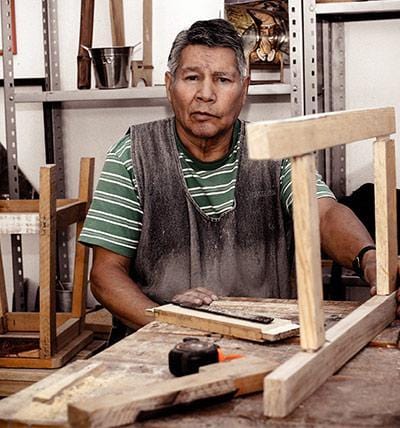The world is very much aware of the environmental consequences of our choices, and amidst our choices, interior design is also going through a meaningful transformation. The idea of creating a stylish home is no longer just about aesthetics—it’s about intention, ethics, and a deeper connection to nature.
Sustainable style has emerged as a powerful movement, combining timeless beauty with eco-conscious materials that reduce harm to the planet.
Whether you're decorating a new space or slowly curating your forever home, embracing natural materials can help you build an interior that’s not only beautiful but also kind to the Earth. From reclaimed wood and bamboo to organic fabrics and responsibly sourced tiles, here’s how to create a home that looks good and does good.
Reclaimed Wood: Character with a Conscience
Few materials bring warmth and soul to a space like wood—but not all wood is created equal. Using reclaimed wood gives new life to previously used materials, whether from old barns, factories, or discarded furniture.
It reduces the demand for virgin lumber, limits deforestation, and gives your home a unique, storied character that mass-produced items simply can't match.
Reclaimed wood can be used for everything from hardwood floors and wall cladding to custom dining tables and shelving. Its imperfections—knots, nail holes, and patina—are part of its charm and a visual reminder of its journey.
Pair it with sleek elements like metal or glass for a modern-rustic balance, or go full cozy cabin with layers of wood grain throughout.

Bamboo: Fast-Growing and Fabulous
One of the most renewable materials on the planet, bamboo is a dream material for eco-conscious interiors. It grows rapidly (some species up to three feet per day!), requires minimal water, and regenerates naturally after harvesting.
As a result, bamboo offers a sustainable alternative to traditional hardwoods without compromising on strength or beauty.
Use bamboo for flooring, blinds, wall panels, or even furniture pieces like stools and chairs. Its light tone works particularly well in minimal, Scandinavian-inspired spaces, helping to brighten rooms while maintaining a natural aesthetic.
For bathrooms or kitchens, bamboo accessories like soap trays, drawer organizers, and cabinetry details offer stylish, eco-friendly functionality.
Terracotta Tiles: Earthy Elegance with Purpose
Terracotta—Italian for "baked earth"—is one of the oldest building materials known to humankind, and for good reason. Made from natural clay and fired at low temperatures, terracotta tiles bring warmth, texture, and timeless appeal to interiors. But not all terracotta is created equal.
If you’re looking to elevate your space sustainably, consider Clè’s premium terracotta tiles. These tiles are handcrafted using traditional methods and responsibly sourced materials, making them a perfect fit for eco-friendly interiors. T
heir earthy tones and natural imperfections work beautifully in kitchens, entryways, and even bathroom walls, offering a grounded, tactile feel that complements everything from rustic wood to modern concrete.
Terracotta is also durable, biodegradable, and requires minimal processing, which lowers its carbon footprint. It's a subtle but powerful way to bring artisanal craftsmanship and environmental awareness into your space.
Organic Fabrics: Soft Touches with a Clean Conscience
The textiles we bring into our homes—curtains, bedding, upholstery, and rugs—often carry hidden environmental costs. Conventional cotton production, for example, uses massive amounts of water and pesticides. Synthetic fabrics can contain microplastics and petrochemicals that aren’t great for our health or the planet.
That’s where organic and natural fabrics come in. Look for textiles made from organic cotton, hemp, linen, and wool. These materials are biodegradable, breathable, and often more durable than their synthetic counterparts. Bonus: they feel amazing.
Add layers of texture to your rooms with organic linen throw pillows, cotton gauze curtains, or a hand-woven jute rug. Opt for plant-based dyes or undyed fabrics to further reduce the environmental impact. Not only will your space look effortlessly elegant, but you'll also be reducing toxins in your indoor air quality—something synthetic materials often compromise.
Ethically Made Accessories: Less, but Better
In a sustainably styled home, every object has a purpose and a story. Instead of crowding shelves with fast décor from big-box retailers, shift your focus to ethically made accessories crafted by artisans using responsible practices.
Think hand-thrown ceramics, recycled glass vases, or baskets woven from seagrass or rattan. These items not only add a tactile richness to your interiors but also support communities and preserve traditional craftsmanship around the world.
When sourcing accessories, pay attention to transparency: does the brand disclose how and where their products are made? Are they using renewable materials or fair-trade practices? Choose fewer items, but make them count.
Low-VOC Paints and Natural Finishes
Sustainable style goes beyond materials you can touch. The paints, finishes, and adhesives used in interior design can significantly impact both your health and the environment. Many conventional products contain VOCs (volatile organic compounds) that off-gas toxins into your home for months after application.
Instead, opt for low-VOC or zero-VOC paints, water-based finishes, and natural sealants like beeswax or plant oils. These are safer for you, better for indoor air quality, and often biodegradable.
Natural limewash or clay paints are also beautiful alternatives, providing a textured, organic look that pairs well with wooden accents, linen textiles, and—you guessed it—terracotta tiles.
Design Mindfully, Live Intentionally
Ultimately, sustainable interior design isn’t just about what materials you use—it’s about how you think. Design becomes sustainable when it’s slow, intentional, and rooted in longevity. Instead of following trends, think about creating a space that evolves with you, one that values comfort, meaning, and natural connection over surface-level perfection.
Reuse and repurpose where you can. Salvage vintage pieces, upcycle old furniture, or trade items with friends and neighbors. Let go of the pressure to have everything “finished” and embrace the journey of curating a home that reflects who you are and what you care about.
Final Thoughts
Sustainable style is more than a design trend—it’s a lifestyle choice that reflects respect for the environment and a desire for deeper authenticity in our spaces. By choosing natural materials like you can create interiors that are not only stunning, but also deeply aligned with the values of care, craftsmanship, and conscious living.
In the end, a sustainable home isn’t just where you live—it’s a space that helps you live better.
ABOUT THE AUTHOR
Aleksandra Djurdjevic
Senior Content Creator
Aleksandra Djurdjevic is a senior writer and editor, covering jewelry, accessories, and trends. She’s also works with services, home décor. She has previously worked as ESL teacher for English Tochka. Aleksandra graduated from the Comparative Literature department at the Faculty of Philosophy in Serbia. Aleksandra’s love for the environment, crafts and natural products over the years helps her continue to be a top expert at Wooden Earth.






